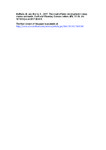The onset of fabric development in deep marine sediments
| dc.contributor.author | Maffione, M | |
| dc.contributor.author | Morris, A | |
| dc.date.accessioned | 2017-09-05T16:14:14Z | |
| dc.date.issued | 2017-09-15 | |
| dc.identifier.issn | 0012-821X | |
| dc.identifier.issn | 1385-013X | |
| dc.identifier.other | C | |
| dc.identifier.uri | http://hdl.handle.net/10026.1/9895 | |
| dc.description | publisher: Elsevier articletitle: The onset of fabric development in deep marine sediments journaltitle: Earth and Planetary Science Letters articlelink: http://dx.doi.org/10.1016/j.epsl.2017.06.018 content_type: article copyright: © 2017 Elsevier B.V. All rights reserved. | |
| dc.description.abstract |
Post-depositional compaction is a key stage in the formation of sedimentary rocks that results in porosity reduction, grain realignment and the production of sedimentary fabrics. The progressive time-depth evolution of the onset of fabric development in deep marine sediments is poorly constrained due to the limited quantity and resolution of existing data. Here we present high-resolution anisotropy of magnetic susceptibility (AMS) results from clay-rich deep marine sediments recovered at International Ocean Discovery Program Site U1438 (Philippine Sea). AMS is a petrofabric tool sensitive to the preferred orientation of grains in rocks. Down-section variations of AMS parameters, density, porosity and the inclination of magnetic remanences demonstrate that fabrics develop in response to compaction and dewatering but also that they do not develop progressively with depth below the mudline. Instead, a horizontal foliation first forms at 83 mbsf once the sediment load reaches an effective stress threshold for the onset of compaction and is then continuously enhanced down to 113 mbsf, defining a 30 m-thick ‘initial compaction window’. The magnetostratigraphic age model for IODP Site U1438 indicates a delay of 5.7 Ma in initial fabric formation following sediment deposition, with strongly defined fabrics then taking an additional 6.5 Ma to develop. | |
| dc.format.extent | 32-39 | |
| dc.language | en | |
| dc.language.iso | en | |
| dc.publisher | Elsevier BV | |
| dc.subject | Sedimentary fabric | |
| dc.subject | deep marine | |
| dc.subject | compaction | |
| dc.subject | magnetic anisotropy | |
| dc.subject | AMS | |
| dc.subject | International Ocean Discovery Program | |
| dc.title | The onset of fabric development in deep marine sediments | |
| dc.type | journal-article | |
| dc.type | Journal Article | |
| plymouth.author-url | https://www.webofscience.com/api/gateway?GWVersion=2&SrcApp=PARTNER_APP&SrcAuth=LinksAMR&KeyUT=WOS:000409150600005&DestLinkType=FullRecord&DestApp=ALL_WOS&UsrCustomerID=11bb513d99f797142bcfeffcc58ea008 | |
| plymouth.volume | 474 | |
| plymouth.publication-status | Accepted | |
| plymouth.journal | Earth and Planetary Science Letters | |
| dc.identifier.doi | 10.1016/j.epsl.2017.06.018 | |
| plymouth.organisational-group | /Plymouth | |
| plymouth.organisational-group | /Plymouth/Faculty of Science and Engineering | |
| plymouth.organisational-group | /Plymouth/Faculty of Science and Engineering/School of Geography, Earth and Environmental Sciences | |
| plymouth.organisational-group | /Plymouth/REF 2021 Researchers by UoA | |
| plymouth.organisational-group | /Plymouth/REF 2021 Researchers by UoA/UoA07 Earth Systems and Environmental Sciences | |
| plymouth.organisational-group | /Plymouth/Research Groups | |
| plymouth.organisational-group | /Plymouth/Research Groups/Marine Institute | |
| plymouth.organisational-group | /Plymouth/Users by role | |
| plymouth.organisational-group | /Plymouth/Users by role/Academics | |
| plymouth.organisational-group | /Plymouth/Users by role/Researchers in ResearchFish submission | |
| dcterms.dateAccepted | 2017-06-08 | |
| dc.rights.embargodate | 2018-6-30 | |
| dc.identifier.eissn | 1385-013X | |
| dc.rights.embargoperiod | 24 months | |
| rioxxterms.versionofrecord | 10.1016/j.epsl.2017.06.018 | |
| rioxxterms.licenseref.uri | http://www.rioxx.net/licenses/under-embargo-all-rights-reserved | |
| rioxxterms.licenseref.startdate | 2017-09-15 | |
| rioxxterms.type | Journal Article/Review | |
| plymouth.funder | Rotation of the Philippine Sea Plate (IODP Expedition 351)::NERC |


